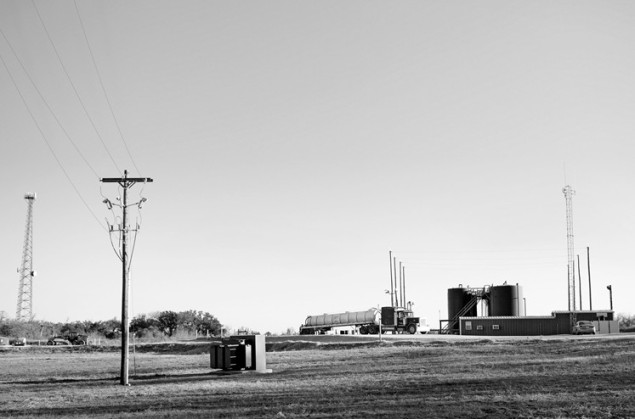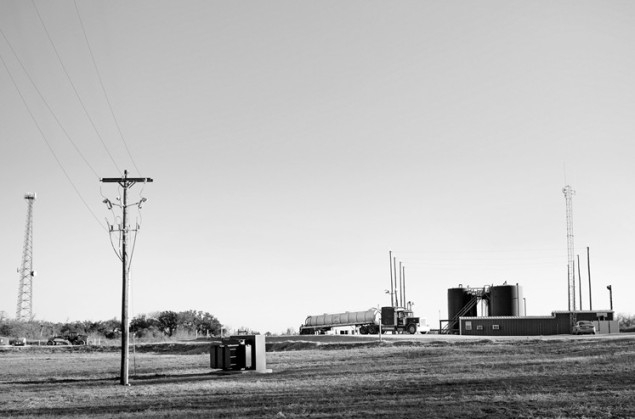
There exists in the Texas House of Representatives a Subcommittee on Seismic Activity, which isn’t something you’d think would exist in this state. But it does, and it’s chaired by Denton’s Rep. Myra Crownover. She convened a hearing Monday to discuss the earthquakes that have rattled the southeast corner of Parker County, around Reno and Azle–an area that, until November of last year, had never reported a single felt tremor. It has had dozens now, and the United States Geological Survey suspects it has something to do with disposal wells near the epicenters, where many millions of gallons of waste water from gas wells are pumped nearly two miles beneath the surface, into the Ellenburger Formation. The phenomenon is the subject of a feature story in this month’s issue of D.
It sounds like the height of hubris to claim that humans can cause the earth’s crust to shudder and release unfathomable energies. But we’ve been doing it for decades, here in Texas and elsewhere. The only difference now–the only reason there’s a subcommittee–is that the shaking is happening near a slightly more populous area than in swarms past, and the fears of the people in Parker County can no longer be ignored.
The Texas Railroad Commission claimed initially that there was little science to back up the assertion that the earthquakes are related to oil and gas production, despite the fact that peer-reviewed study after peer-reviewed study can be found with a cursory Google search. They’ve since qualified that statement and hired a staff seismologist, who will ostensibly reach the same conclusion his peers already accept: That we are fundamentally upsetting an equilibrium below the surface, and the result will be difficult, if not impossible, to predict.
Researchers are beginning to figure out how much they don’t know–namely, how powerful can they get, and how long may they take to show up after a disposal well begins operating? It can be months or it can be decades, and the shale oil and gas boom began in earnest only a few years ago.
These are the issues under discussion, and the subcommittee did indeed call the right folks. Southern Methodist University’s Heather DeShon and Brian Stump, the geophysicists studying the seismic swarm, testified at the hearing. Their investigative task isn’t an easy one. Some 12 seismic monitors have pinpointed the epicenters, clustered just north of Reno. But the kind of data that pushes them beyond correlations in time and space–granular numbers for disposal volumes and pressures, and detailed subsurface maps–have always been tough to come by for researchers because the industry isn’t normally inclined to share them. The Railroad Commission, for example, requires companies to report injection volumes and pressures yearly, each November. That means the researchers only have reports through October, the month before the earthquakes kicked off. This is the reality every researcher who has ever studied induced seismicity runs up against. Anecdotally, a scientist with the Lamont-Doherty Earth Observatory told me he’d never heard of the industry sharing proprietary data with the research community. What would they possibly have to gain by doing so?
But to do the work, Stump told the subcommittee, they need access to these numbers in a “timely manner.”
That it hasn’t been done already is remarkable, but the RRC said it would ask the disposal well operators in the Reno-Azle area to turn in their data early.
Rep. Phil King, the Republican from Weatherford, pointed out that “the good news is we haven’t had any seismic activity in a couple of months. The bad news is it could start tomorrow.”
And on that point he’s right, yet the earthquakes continue, as recently as May 7, though at a magnitude too weak to be felt. And they’re spreading. “While most earthquakes are in the original source area, north of Reno, there have been recent small magnitude, non-felt earthquakes that have migrated to the southwest in March and early April,” DeShon said.
Rep. Terry Canales tried to argue the meaning of “migrate.” But the fact that the seismic activity has apparently moved beyond its initial cluster, activating new faulting, was a new and disquieting revelation that couldn’t be downplayed.
So, what’s going to be done about it? Crownover places great faith in the industry, and its interest in self preservation and conservation. She channeled Pollyanna when she said, “I think the industry would be willing to pay millions and millions of dollars to not just pump (wastewater) underground.”
One would hope in the midst of a drought that permanently removing billions of gallons from the hydrologic cycle would be unconscionable.
But the fact is, the industry recycles only 5 percent of its water in the Barnett Shale. In the Eagle Ford, in South Texas, it’s basically 0 percent. The reason this problem remains so intractable is that deep injection is the only cost-effective way to dispose of the billions of gallons produced in the oil and gas fields. Without injection, shale makes no economic sense.
Even if or when DeShon and Stump get the data they need to identify the relationship between disposal wells and earthquakes, whose responsibility will it be to act?
According to Milton Rister, RRC executive director, the decision to act will fall to the Railroad Commissioners. Which is why I gathered from this hearing that the folks near Azle, and those who have felt earthquakes in East Texas, West Texas and South Texas–really anywhere there’s shale–will have to tolerate a certain amount of seismicity for the foreseeable future. The monitoring will continue. But until the shaking finds its way to Austin, nothing will change.





